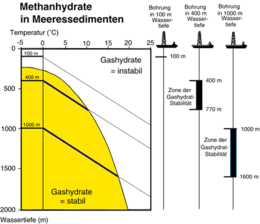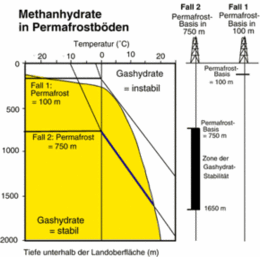Page path:
- General/Marine Geology
- Gas Hydrate Research
- Natural Gas Hydrates
Natural Gas Hydrates
Naturally occurring gas hydrates can be based on various gases. For instance, nitrogen hydrate form in the Greenland ice sheet and CO2 hydrate has been shown to exist on other planets. A frequent type of gas hydrate on earth is methane hydrate. The conditions required for its stability can be present in marine sediments as well as in permafrost soils at the polar regions.
Apart from adequate temperature and pressure conditions, gas hydrate formation depends on the availability of gas, primarily CH4. Most of the methane found in marine sediments is produced by enzymatic decomposition of organic components or by microbial reduction of CO2 in sediments. In cases methane is produced by thermocatalytic alteration of organic matter in deeper sediments. CH4 production is highest at the continental margins, where elevated plankton productivity and high sedimentation rates yield large amounts of organic matter, which serves as substrate for gas production in the sediment. Therefore, gas hydrate is found at almost all passive and active margins. However, there are also deposits in the Caspian Sea, the Black Sea, the Mediterranean and Lake Baikal.
Apart from adequate temperature and pressure conditions, gas hydrate formation depends on the availability of gas, primarily CH4. Most of the methane found in marine sediments is produced by enzymatic decomposition of organic components or by microbial reduction of CO2 in sediments. In cases methane is produced by thermocatalytic alteration of organic matter in deeper sediments. CH4 production is highest at the continental margins, where elevated plankton productivity and high sedimentation rates yield large amounts of organic matter, which serves as substrate for gas production in the sediment. Therefore, gas hydrate is found at almost all passive and active margins. However, there are also deposits in the Caspian Sea, the Black Sea, the Mediterranean and Lake Baikal.

Physical conditions (temperature and pressure) required for the stability of methane hydrate in a marine environment. Assuming a constant temperature of 0°C, e.g. in polar regions, methane hydrate cannot be stable at a water depth of 100 m. However, it may occur in the seafloor which is more than 400 m below sea level. The thickness of the hydrate zone depends on the temperature gradient. However, with an increasing depth below the seafloor, temperatures get too high for gas hydrate stability, so that only free gas and water are present. Given an average temperature increase by 3°C per 100 m sediment depth (geothermal gradient), when drilling at a water depth of 300 m, we can expect to find a 300-m-thick hydrate layer. At 1000 m water depth, the layer will be 600 m thick. If, however, sediments are characterized by a stronger increase in temperature, which can be the case e.g. at active continental margins (4-6°C per 100 m depth), the hydrate zone will generally be thinner. Gas hydrate has been found in sediments up to 1100 m below the seafloor.

In permafrost areas, the temperature gradients are considerably lower than in the marine environment. As shown in this figure, the temperature can be expected to increase by 1.3°C per 100 m within the permafrost zone, compared to 2°C per 100 m in layers below the permafrost zone. The ambient temperature and the thickness of the frozen layer are of paramount importance for the stability of gas hydrate. If the permafrost base is located at a depth of 100 m or less (case 1), physical conditions will not be adequate for a formation of gas hydrate. The situation is different in case 2, where the permafrost basis is located at greater depth. In polar regions, methane hydrate can occur at depths ranging from 150 to 2000 m.


